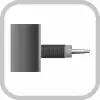ATEX certified products
RECHNER Sensors’ range of ATEX certified products include capacitive and inductive proximity sensors in various size. NAMUR sensors and proximity sensors with NPN or PNP transistor output. With the Ex-protected barriers and amplifiers the product range is complete.
The ATEX-certified units are available for areas with danger of gas explosion (Zone 0,1 and 2) and for areas with danger of dust explosion (Zone 20, 21 and 22). Being an ATEX certified firm, RECHNER can also offer sensors with a manufacturers declaration for both of these explosion danger areas.













